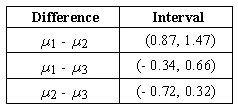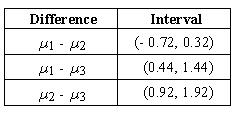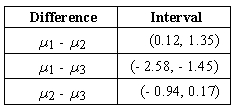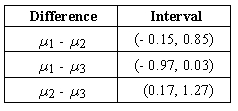Multiple Choice
The supermarket chain chooses a new logo from the three proposed options. A control group of 20 people scores the logos, which are shown in a random order, on a ten-point scale of attractiveness. Let µ1, µ2, and µ3 represent the mean scores for logos 1, 2, and 3 respectively. After using a multiple comparison procedure, the results were announced: The rating of logo 3 significantly differs from the ratings of logo 1. The rating of logo 1 is approximately equal to the rating of logo 2. The rating of logo 2 significantly differs from the ratings of logo 3. Which of the following sets of Tukey-Kramer intervals is consistent with the conclusions?
A) 
B) 
C) 
D) 
E) 
Correct Answer:

Verified
Correct Answer:
Verified
Q30: In an experiment on anticipated test performance,
Q31: SSE measures the within-sample variability.
Q32: In a randomized block design, the test
Q33: The fundamental identity in a two-factor ANOVA
Q34: The following partial ANOVA table was based
Q35: The objective of a single-factor analysis of
Q37: In a study of the effects of
Q38: When the discrepancies between the values of
Q39: What are the assumptions of the two-factor
Q40: The P-value associated with the calculated F